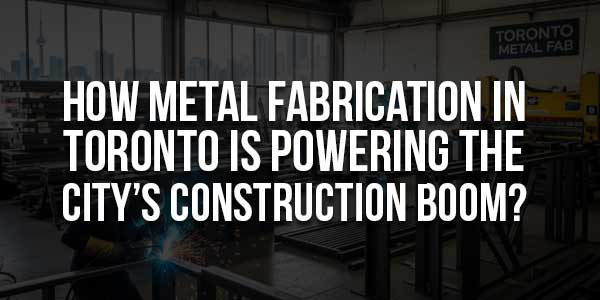
Toronto’s skyline has been growing at a humongous scale over the past decade or so. From new high-rise condos to massive commercial developments, the city is experiencing one of its largest building booms in decades. Metal fabrication is central to all that is driving it behind the scenes.
All the beams, brackets, frames, and panels must be carefully cut and shaped and then quickly assembled. That is where Toronto’s metal fabrication sector has stepped up to the plate—with building pieces that leave projects ahead of time and standing strong.
Table of Contents
What Is Metal Fabrication?
Metal fabrication refers to cutting raw metal into functional components and structures. It includes several crucial steps:
- Cutting – cutting metal components with equipment such as laser cutters or plasma cutters
- Bending – bending tubes or sheet on rollers or press brakes
- Welding – combining metal pieces
- Assembling – assembling pieces into final products
- Finishing – applying paint coats or polishing the surface
All these activities are carried out in-house by most Toronto fabrication facilities, which is cost-effective and means less need to deal with multiple vendors.
- Precision is everything in construction. A small measurement error or panel cut can hold up an entire build schedule. Local metal fabricators come to the rescue by:
- Producing accurate pieces that fit the first time
- Offering rapid turnaround to catch tight deadlines
- Making quick design or spec changes when conditions change
- Incorporating quality control to avoid on-site holdups at a premium price
This is an extremely tight relationship between fabrication and building that builders and contractors in Toronto use so commonly.
Quick Comparison: Local Fabrication vs. Outsourced Parts
| Factor | Local Toronto Fabrication | Outsourced Fabrication |
| Lead Time | Short, flexible | Long, fixed |
| Communication | Direct and quick | Delayed by time zones |
| Quality Control | Easy to monitor on-site | Harder to oversee remotely |
| Shipping Costs | Minimal | High for heavy materials |
| Design Changes | Can be handled quickly | Often requires restarting the process |
How Fabrication Drives Toronto’s Building Boom?
The city building boom has generated awe-inspiring demand for high-volume, high-quality metal fabrication. Regional facilities have answered the challenge with:
- Gigantic gear – Big CNC machines, laser cutters, and welding stations that process bulk orders in an instant
- Master craftsmen – Trained technicians who can work on complex building parts with precise tolerances
- One-of-a-kind capabilities – Ability to manufacture unique architectural units and duplicate structural details
- Speed and agility – Retailers can reorganise schedules and staff to meet changing construction schedules
Such qualities enable builders to have the required products delivered on time, avoiding on-site delays at a high cost.
The Types of Metal Products Used in Construction:
Toronto metal fabricators manufacture an assortment of components essential to buildings and infrastructure. Some of the common products are:
- Structural steel columns and beams
- Stairways, railings, and ladders
- HVAC ducts and supports
- Window frames and curtain wall systems
- Roof trusses and framing brackets
They are mostly custom-made for a single project, and for that reason, proximity to fabrication plants is so essential.
The Role of Technology in Current Fabrication:
Advanced technology has accelerated fabrication, improved its precision, and consistency—all demands of large construction projects. Toronto shops are using more and more:
- CAD/CAM software to create and program parts
- Computer-guided cutting and bending Cof NC machines
- Welding robots to accelerate assembly
- Laser cutting equipment for neat, precise cuts
- Digital quality control to monitor every aspect of manufacturing
These technologies enable fabricators to deliver the high standards required in large building construction without impeding progress.

Why Local Fabrication Puts Toronto Ahead?
Local metal fabrication has immense benefits, making Toronto building projects on time:
- Fast delivery – No waiting weeks for out-of-province or overseas deliveries
- Increased coordination – Designers, engineers, and fabricators communicate in real time
- Increased reliability – Errors can be easily fixed before they cause site delay
- Increased supply dependability – Local warehouses can favour local customers during peaks in material demand
This close relationship between builders and fabricators keeps the project on track, which is essential when a building boom is underway.
When Outsourcing Still Makes Sense?
- While local manufacturing is the preferred option for most projects, there are still some situations that require the use of outside vendors:
- Stock lower-cost components mass-produced
- Unique finishes or materials not available locally
- Large projects with flexible timelines where shipping time is not a major concern
- Components made closer to the end-use location (for exports)
Nonetheless, local companies would rather do final calibration or finishing once they receive the components.
Key Points to Note:
- Metal fabrication lies at the core of Toronto’s building boom.
- Local shops offer speed, accuracy, and versatility demanded by large projects.
- High technology, such as CNC and robot welding, improves productivity and accuracy.
- Fabricating with local partners minimises risk, delay, and logistics costs.
FAQs:
- Why is local metal fabrication critical to building projects?
It enables developers to predict and source custom pieces sooner, avoid delays, and fix issues instantly without having to wait for imports from overseas.
- How easy are metals to handle in construction?
Steel, stainless steel, aluminium, and galvanised metals are used most often where building code-compliant structural and architectural pieces are involved.
- How do fabricators ensure parts meet building codes?
They work with certified material, follow engineering standards, and perform in-process and post-fabrication quality assurance tests.
- Can local shops handle large-scale work?
Yes. Most Toronto shops have high-volume capacity equipment and staff to produce bulk orders and custom pieces.
- How does technology improve construction fabrication?
Reducing errors and quickening production are enabled through automation, CAD programming, and real-time monitoring.
Conclusion:
Toronto’s building boom has its origins in something other than concrete and cranes—it has its origins in local metal fabrication. With customised parts fabricated rapidly and precisely, metal fabrication Toronto shops are propelling projects upward, adhering to demanding codes, and staying within budget. As the city keeps expanding skyward, the shops will be part of its cityscape.

 About the Author:
About the Author:












Be the first to write a comment.